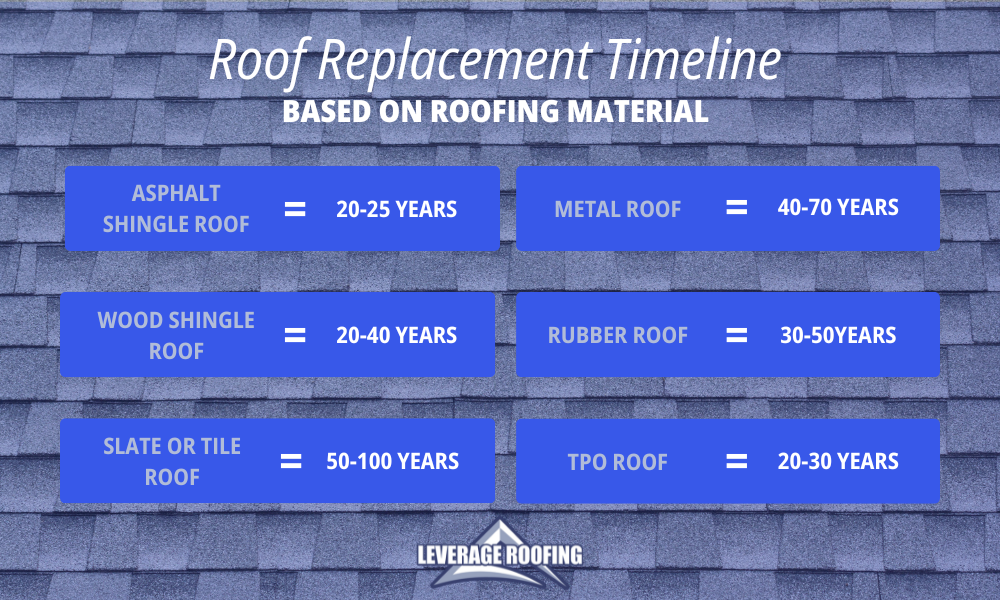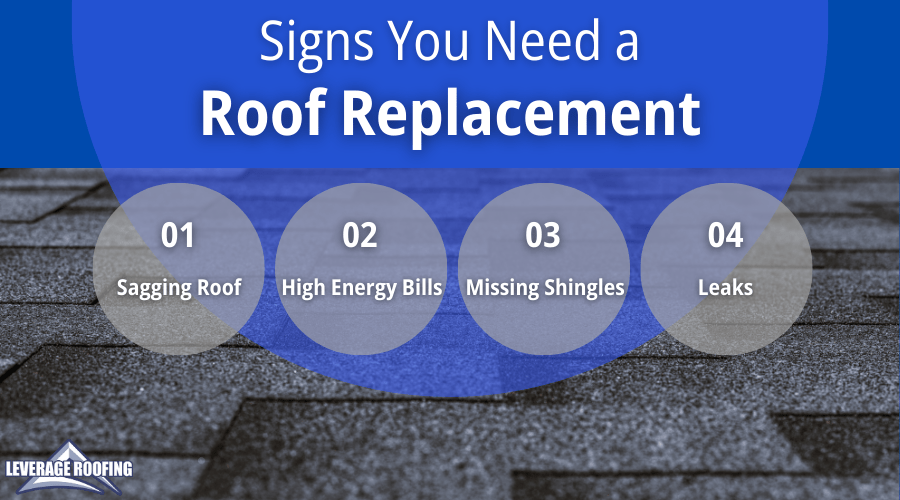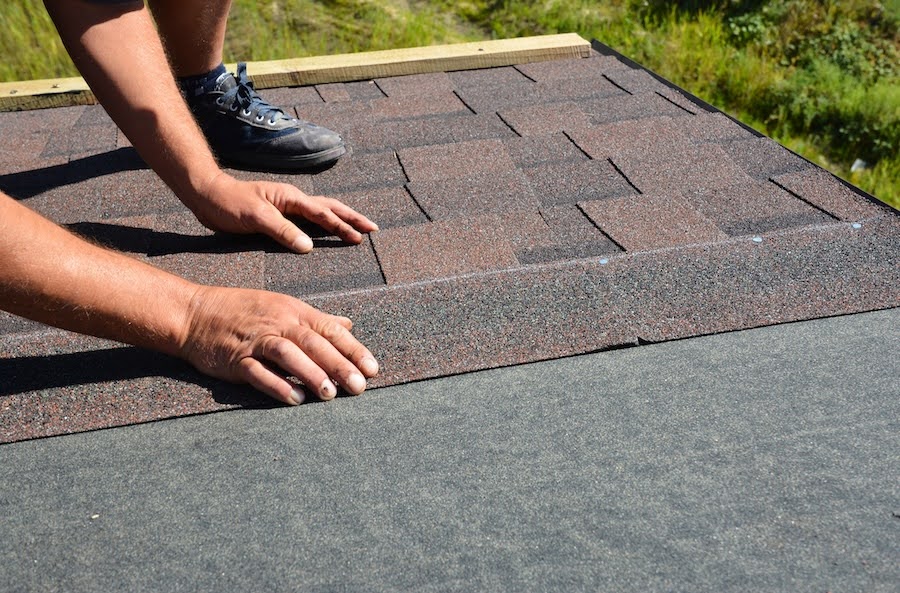Short Answer: A roof typically requires a complete replacement every 20-25 years for asphalt shingles, 40-70 years for metal roofing, and up to 100 years for slate or clay tile roofs.
The exact life expectancy of your roof is influenced by factors like climate, proper maintenance, the quality of installation, and weather conditions. Extreme weather conditions and regular roof inspections play a vital role in extending the roof’s lifespan and identifying warning signs of potential damage.
Although a new roof is a long-term investment, roof damage and wear are inevitable over time. Regular maintenance and timely roof repairs, such as replacing missing shingles or tiles due to high winds, are crucial for preventing significant damage. A roof’s lifespan can also vary depending on the type of roofing material used, whether it’s an asphalt shingle roof, a metal roof, or clay tiles, as well as storm and water damage. Regular inspections by a professional roofer can help identify issues early and ensure proper ventilation, protecting the integrity of your roofing system.

Roof Replacement Timeline Based on Roofing Material
With proper installation, attic ventilation, regular maintenance, and necessary repairs, most roofs will need a full replacement every 20 to 50 years. Local conditions across different parts of the country have a significant impact on how long your roof will last. The biggest factor, though, is typically the roofing material. Some materials are better suited for specific regions than others.
Asphalt Shingles: 20 – 25 Years
If your roof isn’t dealing with harsh conditions like high winds or extreme temperatures, asphalt shingles should last around 20-25 years. By the 22-year mark, you’ll want to start thinking about budgeting for a replacement. Whether you choose 3-tab or architectural shingles, going for a higher-quality option will give you better performance and a longer lifespan.
Wood Shingles: 20 – 40 Years
Wood shingles, particularly cedar shakes, can last between 20 and 40 years, but they require regular maintenance and repairs. They’re also more prone to issues like roof insect infestations
and leaks. While wood shingles are a good option for eco-friendly roofs, there are other materials with longer lifespans and fewer maintenance needs that might be a better choice.
Slate and Roof Tile: 50 – 100 Years
Tile roofs can last a long time, anywhere from 50 to 100 years, depending on the type. Clay tile typically lasts about 50 years, cement tiles can last up to a century, and slate tile roofs often last 75 years or more. These roofs are durable, but because of their weight, it’s important that your home’s structure can support them from the start.
Metal Roof: 40 – 70 Years
A metal roof is built to last, typically 40 years or more, with some high-quality options lasting up to 75 years. They’re also a good choice for homes that might have sagging roofs, as they can be installed on wooden strips that don’t rely on the roof deck. This makes them a great option for older homes built before modern specifications.
Rubber Roofs (EPDM): 30 – 50 Years
For flat or low-slope roofs, EPDM rubber roofing can last between 30 and 50 years. They’re a solid investment, especially on roofs with higher slopes or in areas with minimal snowfall. While they can handle many climates, their best use is on large roofs or businesses that need a durable option for long-term performance.
TPO Roofing (Single-Ply Membrane): 20 – 30 years
For commercial buildings, TPO or single-ply membrane roofing is a popular choice. These synthetic membranes can last up to 30 years and offer great customization options for installation, including ballast, mechanical fasteners, and adhesives. This helps ensure solid, long-lasting performance.

Signs You Might Need a Roof Replacement
- Age of the Roof: Every roofing material has an expected lifespan. If your roof is nearing the end of that time frame, it might be time to think about a replacement.
- Leaking and Water Damage: Ongoing leaks or visible water damage inside your home, like stains on ceilings and walls, often point to roof failure and may indicate the need for a new roof.
- Damaged or Missing Shingles: Shingles that are cracked, curled, blistered, or missing altogether show signs of wear and could require a roof replacement.
- Granule Loss: As asphalt shingles age, they lose granules. If you see granules in your gutters or downspouts, it’s a sign that your roof may be nearing the end of its life.
- Sagging Roof: A sagging roof is a clear indication of structural problems, and a roof replacement may be urgently needed to avoid further damage.
- Sunlight Penetration: If you notice sunlight shining through your attic’s roof boards, it’s a definite sign that your roof needs replacing.
- Damaged Flashing: Flashing around elements like chimneys, vents, and skylights can deteriorate or become loose over time. If it’s severely damaged, a full roof replacement may be necessary to prevent leaks.
- Roof Deck Damage: If walking on your roof feels spongy or bouncy, it might indicate damage to the roof deck that requires attention.
- High Energy Bills: An unexpected increase in energy costs could be caused by poor roof insulation or ventilation, which may signal that a replacement is in order.
- Storm Damage: Severe weather events like heavy storms, hail, or strong winds can cause major roof damage, making a replacement necessary to restore your roof’s integrity.

What Affects Roof Replacement Costs?
The cost of roof replacement is largely determined by factors related to your home. For example, a small roof will naturally cost less than a larger one, and a professional inspection might reveal underlying water damage to the roof decking. Here are some key factors that influence the cost of your roof replacement:
- Insurance Coverage: The price of your roof replacement can vary based on your insurance plan.
- Roof Size and Pitch: Larger, steeper roofs require more materials and labor, driving up the cost.
- Geographic Location: Labor and material prices can fluctuate depending on your region.
- Roof Complexity: Features like skylights, chimneys, and vents will increase the cost of replacement.
- Removal of Old Roof: Additional costs may be added for tearing off and disposing of your old roof.
- Structural Repairs: Any needed repairs to the roof deck or structure will add to the overall cost
- Permits and Inspections: Local building codes may require permits and inspections, which could increase the price.

How Long Does Roof Replacement Take?
The time it takes to complete a full roof replacement is influenced by several factors. Understanding these elements can help you better plan for the project and set realistic expectations for when your new roof will be finished.
- Scope of Work: A smaller, simpler roof can usually be replaced relatively fast. However, the larger and more straightforward the roof, the quicker the process tends to be. Homes with a basic, uncomplicated roof structure typically see faster project completion.
- Project Details: If your roof has more intricate features, such as dormers, skylights, or a complex layout, the replacement will naturally take longer. These details require more careful planning, specialized work, and extra time to ensure that everything fits together properly, increasing the total project duration.
- Roofing Materials: The type of roofing material you choose can also impact how long the replacement takes. For instance, metal roofing is generally quicker to install than materials like tile or slate. If your roof needs structural adjustments for heavier materials, such as reinforcing the decking to support tile or slate, this will extend the time required for the job.
- Weather: Weather conditions play a crucial role in the speed of a roof replacement. Dry, clear weather allows the roofing team to work efficiently and without interruption. On the other hand, working in wet or extreme conditions, such as during the rainy season, can delay the project, as it’s important to avoid having the roof exposed to the elements before it’s fully protected.
By considering these factors, you can get a better sense of the timeline for your roof replacement and avoid any surprises along the way.

Trust the Pros at Leverage Roofing
When it comes to your roof replacement, choosing a professional and reliable roofing contractor like Leverage Roofing ensures that you start with a solid foundation that extends the lifespan of your roof. Whether you’re opting for architectural asphalt shingles, slate roofing, or clay tiles, our team can address a range of issues, from sagging roofs to full replacements, all while providing proper maintenance and implementing processes to prevent further damage.
At Leverage Roofing, we offer a wide range of services designed to meet your home improvement needs, including:
-
- Siding installation and repair
- Roof installation and repair
- Seamless gutters
- Pressure washing
- Assistance with insurance claims
- And more!
Our experienced team is committed to providing durable, attractive, and low-maintenance siding solutions that stand the test of time. Whether you need to upgrade your siding or find effective ways to maintain it, we’re here to deliver reliable results that enhance both the functionality and aesthetic value of your home. Contact us today to schedule an inspection and discover how we can elevate your home’s durability, aesthetic appeal, and overall value.
Resources:
https://www.waterproofmag.com/2022/05/benefits-of-ballasted-roofing/
https://www.bhg.com/home-improvement/windows/what-is-a-dormer/


